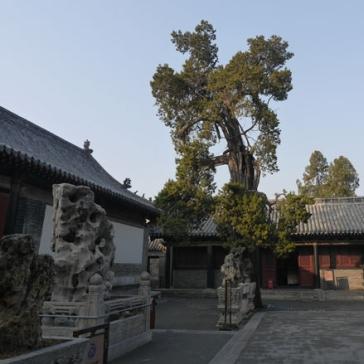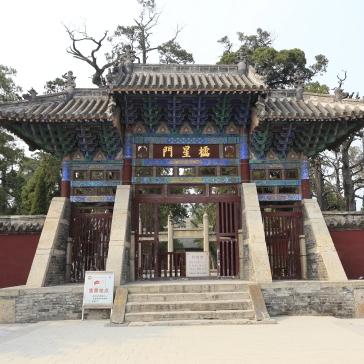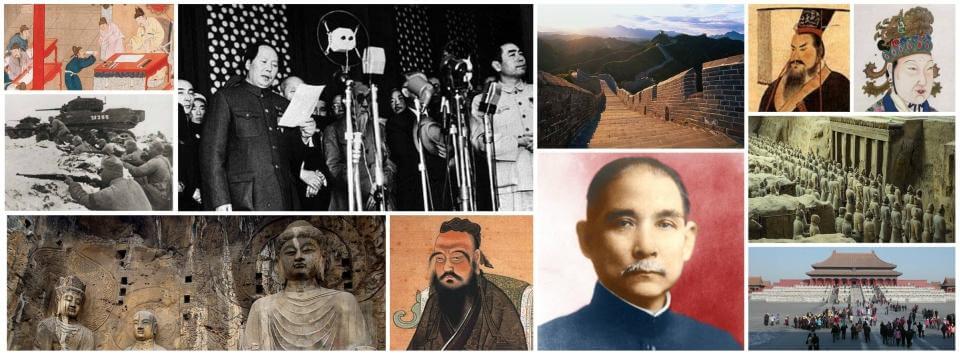
Zhou Dynasty (1046 - 256 BC)
The Western Zhou Dynasty (1046 – 771 BC)
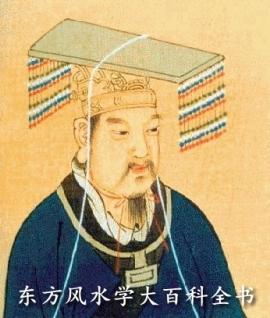 King Tai of ZhouThe Zhou people who overthrew the Shang dynasty were originally one of their subordinate peoples that lived on the Western side of the Shang heartland along the Wei River. They also had made the leap from a hunting and gathering society to an agricultural society, but eventually reverted back to hunting and gathering before building their permanent settlements and becoming a tributary group within the Shang state.
King Tai of ZhouThe Zhou people who overthrew the Shang dynasty were originally one of their subordinate peoples that lived on the Western side of the Shang heartland along the Wei River. They also had made the leap from a hunting and gathering society to an agricultural society, but eventually reverted back to hunting and gathering before building their permanent settlements and becoming a tributary group within the Shang state.
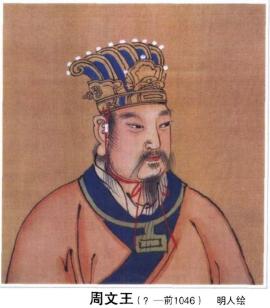 King Wen of ZhouThe Zhou people became resentful of the unsatisfactory leadership of the Shang rulers around the 12th and the beginning of the 11th century BC and began to assert their ambition of overthrowing the Shang rulers. A Zhou ruler named Tai was a key figure in making this ambition known and developed a plan for the overthrow of the Shang which was then explicitly followed over the next three generations. The Zhou people began to migrate eastward along the Wei River which quickly brought them in much closer contact with the Shang and they developed alliances with other peoples who also lived along the Western periphery of the Shang state.
King Wen of ZhouThe Zhou people became resentful of the unsatisfactory leadership of the Shang rulers around the 12th and the beginning of the 11th century BC and began to assert their ambition of overthrowing the Shang rulers. A Zhou ruler named Tai was a key figure in making this ambition known and developed a plan for the overthrow of the Shang which was then explicitly followed over the next three generations. The Zhou people began to migrate eastward along the Wei River which quickly brought them in much closer contact with the Shang and they developed alliances with other peoples who also lived along the Western periphery of the Shang state.
In the year 1050 BC, the Zhou leader Wen (later referred to as King Wen) prepared the final military plan that led to the eventual demise of the Shang and that was executed by his son King Wu sometime around 1046 or 1045 BC (the exact date is unknown). At that time, the Zhou army along with their military allies marched to the Shang capital Yin (present day Anyang in the North of Henan province) and attacked the city from the Western side. Before the attack, King Wu gave a rousing speech in which he claimed that heaven had withdrawn the mandate (see mandate of heaven) from the Shang rulers and given it to the Zhou people.
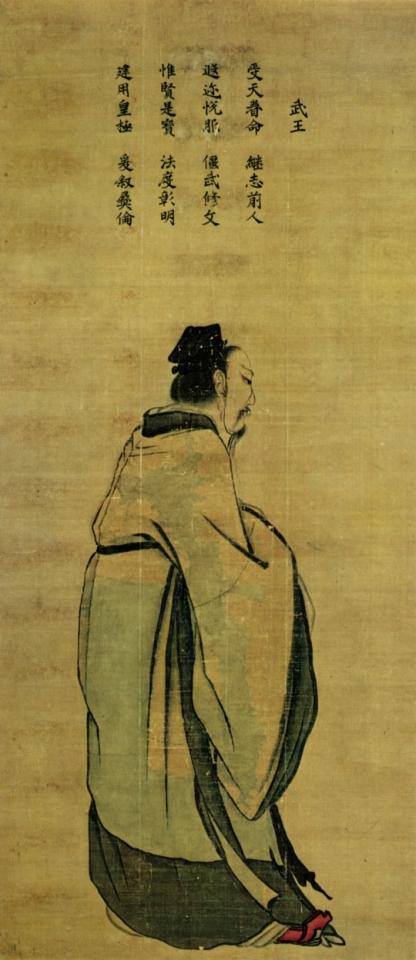 King Wu of ZhouThe ensuing battle of Muye is described in a poem in the oldest surviving collection of Chinese poetry. The Zhou army used their bronze swords and axes to great effect in the ensuing day-long battle (written reports mention pieces of wood floating on rivers of blood along the streets of the capital) and the Zhou victory was complete with them in control of the former Shang capital. The Shang ruler committed suicide by lighting a fire in which he burned to death.
King Wu of ZhouThe ensuing battle of Muye is described in a poem in the oldest surviving collection of Chinese poetry. The Zhou army used their bronze swords and axes to great effect in the ensuing day-long battle (written reports mention pieces of wood floating on rivers of blood along the streets of the capital) and the Zhou victory was complete with them in control of the former Shang capital. The Shang ruler committed suicide by lighting a fire in which he burned to death.
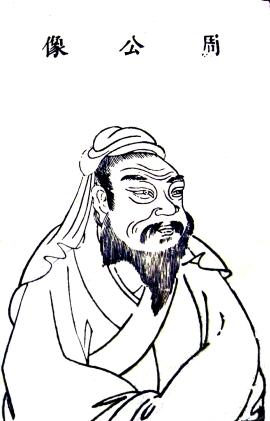 A portrait of the Duke of Zhou from Sancai Tuhui by Wang Qi (AD 1529 - 1612)Since King Wu was still a relatively young boy at the time of the conquest, his uncle - the Duke of Zhou (the younger brother of King Wen) - can be assumed to have carried much of the responsibility and authority at that time. He is reported to have been a virtuous character (and supposedly a great role model for Confucius) and acted as political advisor of his nephew King Wu instead of trying to usurp the throne at these unstable times.
A portrait of the Duke of Zhou from Sancai Tuhui by Wang Qi (AD 1529 - 1612)Since King Wu was still a relatively young boy at the time of the conquest, his uncle - the Duke of Zhou (the younger brother of King Wen) - can be assumed to have carried much of the responsibility and authority at that time. He is reported to have been a virtuous character (and supposedly a great role model for Confucius) and acted as political advisor of his nephew King Wu instead of trying to usurp the throne at these unstable times.
After their victory, the Zhou began to dismantle the institutions of the Shang state and replaced them with their own.
They moved the capital of their new state away from present-day Anyang towards their western ancestral homeland in the valley of the Wei River. There seems to be some confusion about the actual location of the Zhou capital. What is clear though is that the Zhou rulers (as well as later dynasties) designed their capital(s) by using ideas from various fields, such as cosmology, feng shui etc. Their capital was laid out within a rectangular space that was surrounded by a tall city wall and oriented along a North-South axis.
The rulers lived in palatial buildings in the northern part of the new city whereas the common people and their activity centers like markets were located in the southern part. Furthermore, buildings for the performance of certain rituals and sacrifices by the king (and later emperor) were located along the four sides of the rectangular city.
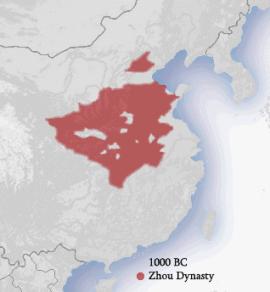 approximate territory of the Zhou dynasty state in ancient ChinaInstead of completely annihilating or trying to assimilate the Shang people, they were given their own territory to the southeast of present-day Anyang. In this way, the reversal of the former political situation was completed with the Shang people becoming a subordinate group to the Zhou. The Shang people kept their former customs and traditions after their move to their new territory, including the ritual worship of their ancestors.
approximate territory of the Zhou dynasty state in ancient ChinaInstead of completely annihilating or trying to assimilate the Shang people, they were given their own territory to the southeast of present-day Anyang. In this way, the reversal of the former political situation was completed with the Shang people becoming a subordinate group to the Zhou. The Shang people kept their former customs and traditions after their move to their new territory, including the ritual worship of their ancestors.
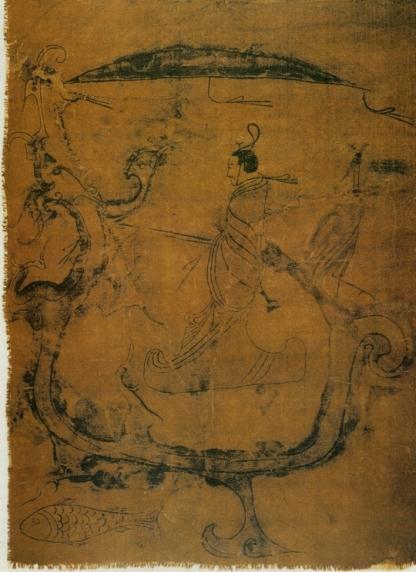 Silk painting featuring a man riding a dragon, dated to 5th century BCThe Zhou people cultivated this ancestor worship as well besides their worship of heaven. Their first 2-3 centuries of leadership were very successful in that their territory continued to expand along with the substantial growth of the human population within their realm. The area within their dominion became about four times as large as the original Shang state by the 8th century BC. Most of the newly controlled areas were gained in the south or southeast of the former Shang heartland.
Silk painting featuring a man riding a dragon, dated to 5th century BCThe Zhou people cultivated this ancestor worship as well besides their worship of heaven. Their first 2-3 centuries of leadership were very successful in that their territory continued to expand along with the substantial growth of the human population within their realm. The area within their dominion became about four times as large as the original Shang state by the 8th century BC. Most of the newly controlled areas were gained in the south or southeast of the former Shang heartland.
The controlled territory of the Zhou state expanded so rapidly and eventually became so large, that it couldn't be administered effectively any longer, which over time resulted in the Zhou kings gradually losing control of their empire. Eventually, they were no longer able to control their entire state from within their capital, but instead began to rely on appointed local rulers, which at first were closely related to them (through ties of blood or marriage). Control of the outlying areas was delegated to members of the royal family, which were assumed to be loyal to the Zhou rulers.
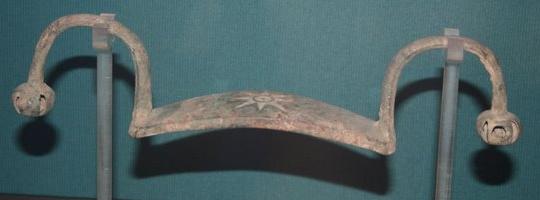 Bronze bow device for controlling chariot reins from the Western Zhou DynastyAs their territory got larger, there were not enough family members left to take control of these new territories. Certain military leaders (who had demonstrated their loyalty to the Zhou kings in military conflicts) were appointed then as rulers of these newly gained territories. This system worked well at the beginning as long as there were close personal bonds between those appointed leaders and the Zhou kings.
Bronze bow device for controlling chariot reins from the Western Zhou DynastyAs their territory got larger, there were not enough family members left to take control of these new territories. Certain military leaders (who had demonstrated their loyalty to the Zhou kings in military conflicts) were appointed then as rulers of these newly gained territories. This system worked well at the beginning as long as there were close personal bonds between those appointed leaders and the Zhou kings.
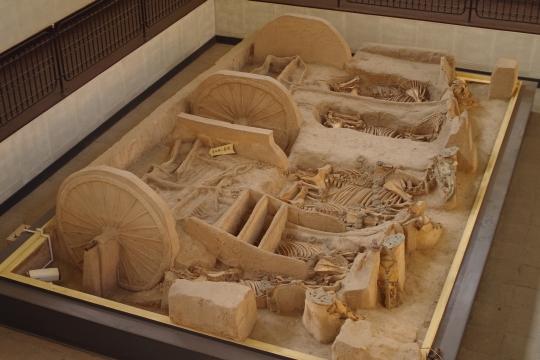 Remains of carriages and horses of the Western Zhou period (1046 – 771 BC)With each passing generation, these bonds weakened as the local leaders passed on their power to their offspring. Furthermore, the succeeding Zhou kings became complacent and mostly stayed within the surroundings of their royal court.
Remains of carriages and horses of the Western Zhou period (1046 – 771 BC)With each passing generation, these bonds weakened as the local leaders passed on their power to their offspring. Furthermore, the succeeding Zhou kings became complacent and mostly stayed within the surroundings of their royal court.
The local leaders, who didn't feel obliged to the faraway Zhou kings anymore, began to resent the need to send a large part of their agricultural surplus and wealth to the faraway Zhou rulers in the form of tributes. They correspondingly decreased their tribute payments which resulted in an ever dwindling state income over a period of successive generations.
By the 8th century BC, some local strongmen began to refer to themselves as kings (Chinese: wang) instead of as dukes, marquises and counts (according to the official nomenclature) in their local written communication, which was a clear subversion of the power of the Zhou kings. However, the Zhou kings didn't punish these transgressions (if ever they heard of them) since they were preoccupied with a different problem. That problem was the emergence of a new people - the Qin people - in the Wei River valleys (so in the original areas of the Zhou people), who began a series of military raids into the Zhou controlled areas.
The Spring and Autumn Period (771 - 476 BC)
 spear with cloud and thunder pattern, early 6th century BC – 476 BCThese security problems became so serious that the Zhou kings were forced to abandon their capital (near modern city of Xi'an) in the year 771 BC in order to move eastward along the Yellow River valleys. That move marks the end of the Western Zhou dynasty and the beginning of the Eastern Zhou dynasty, which was from then on only an inconsequential state. The Eastern Zhou capital was established near the area of present-day Luoyang (in the center of Henan province) and built according to the same pattern of the previous Zhou capitals (rectangular shape, tall walls, north-south axis, . . . ). Thereby preoccupied with the stabilization of their crumbling empire at its center, the Zhou didn't have the power to react in a decisive way against the subversion of some local rulers at its periphery (mostly in the areas south and southwest of the center of the Zhou state).
spear with cloud and thunder pattern, early 6th century BC – 476 BCThese security problems became so serious that the Zhou kings were forced to abandon their capital (near modern city of Xi'an) in the year 771 BC in order to move eastward along the Yellow River valleys. That move marks the end of the Western Zhou dynasty and the beginning of the Eastern Zhou dynasty, which was from then on only an inconsequential state. The Eastern Zhou capital was established near the area of present-day Luoyang (in the center of Henan province) and built according to the same pattern of the previous Zhou capitals (rectangular shape, tall walls, north-south axis, . . . ). Thereby preoccupied with the stabilization of their crumbling empire at its center, the Zhou didn't have the power to react in a decisive way against the subversion of some local rulers at its periphery (mostly in the areas south and southwest of the center of the Zhou state).
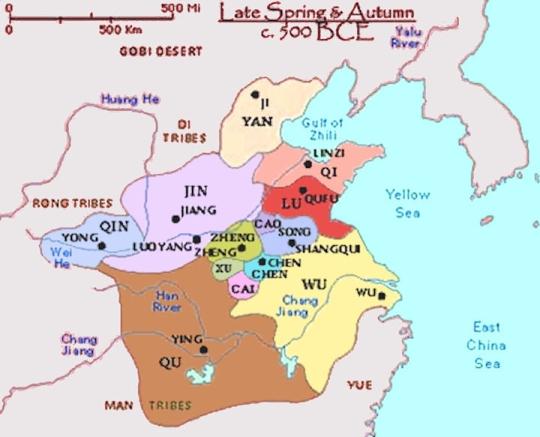 Map of states during the Spring and Autumn Period around 500 BCIn succession, the Zhou state in reality fragmented into a number of small states (Qin, Jin, Yan, Lu, Qi, Chen, Song, Chu, Cai, Wu) even though their rulers at first still claimed allegiance to the succeeding Zhou kings in Luoyang. In reality, the Zhou kings finally only controlled the area in close proximity to their capital. This period of fragmentation (until around 476 BC) is named the "Spring and Autumn Period". It is named after the "Spring and Autumn Annals" that were published in the state of Lu and that chronicle this period year by year from the perspective of the Lu state. Some scholars believe that the "Spring and Autumn Annals" were edited by Confucius himself, who was a native of the Lu state.
Map of states during the Spring and Autumn Period around 500 BCIn succession, the Zhou state in reality fragmented into a number of small states (Qin, Jin, Yan, Lu, Qi, Chen, Song, Chu, Cai, Wu) even though their rulers at first still claimed allegiance to the succeeding Zhou kings in Luoyang. In reality, the Zhou kings finally only controlled the area in close proximity to their capital. This period of fragmentation (until around 476 BC) is named the "Spring and Autumn Period". It is named after the "Spring and Autumn Annals" that were published in the state of Lu and that chronicle this period year by year from the perspective of the Lu state. Some scholars believe that the "Spring and Autumn Annals" were edited by Confucius himself, who was a native of the Lu state.
The rulers of the state of Lu claimed descendence from the Duke of Zhou (younger brother of King Wen, planner of the overthrow of the Shang dynasty and uncle of young King Wu who led the Zhou conquest).
During the Spring and Autumn Period, local hegemons (whom the Chinese chronicles refer to as ba wang - a king in power, but not in right) began to set up royal courts and to perform and even adapt rituals (for example royal ancestor worship) that were traditionally only performed by the real king. The hegemons started to wear royal clothing and had their subordinates pay respect to them as kings.
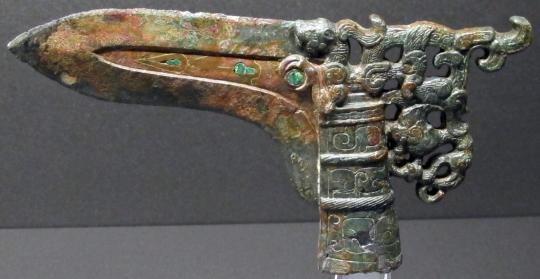 Dagger-axe (Ge) from the Spring and Autumn PeriodSome local hegemons launched military attacks to conquer the territory of weaker neighbouring states or to breakaway from their regional overlord. By the year 500 BC, there were about 250 small states of different sizes in the area that was originally under Zhou control. Some of these consisted of only one fortified town and the surrounding agricultural area whereas others occupied fairly large areas.
Dagger-axe (Ge) from the Spring and Autumn PeriodSome local hegemons launched military attacks to conquer the territory of weaker neighbouring states or to breakaway from their regional overlord. By the year 500 BC, there were about 250 small states of different sizes in the area that was originally under Zhou control. Some of these consisted of only one fortified town and the surrounding agricultural area whereas others occupied fairly large areas.
Due to the proliferation of royal courts, literate people (to facilitate written record-keeping and administration) who could perform the sacrificial rituals (just like the diviners during the Shang dynasty) and royal ceremonies were in high demand. Over time, a new political class emerged that the Chinese call the shi, a class of professional political administrators. They served as political advisors and usually had in-depth knowledge of history (historic annals, texts about ritual worship and sacrifices, texts that served as record keeping) and classic texts (the Confucian classics, poetry and folk songs) and that set them apart from the majority of the population that remained illiterate.
At first, these political advisors were each attached to specific local rulers but over time they became an elite class of people that could be recruited accross regional borders by whoever was willing to pay them. That set in motion a competition among local rulers to attract the best and brightest of them to their own royal court. Some of the shi therefore served a succession of different local hegemons over the span of their professional careers.
After the 6th century BC, some of the shi accumulated such diverse knowledge and experience regarding political and moral ideas and values (like Confucius) that they emerged as important thinkers who began to question the chaos and disorder in the current state of society and developed theories that were meant to bring about a well-ordered state of society again.
The Hundred Schools of Thought
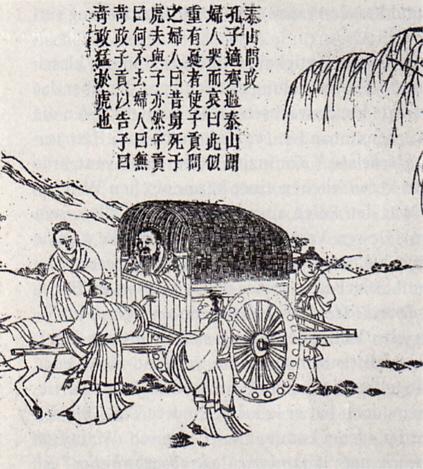 Confucius on his way to the Zhou capital LuoyangThe Hundred Schools of Thought is a term that is commonly used to describe the proliferation of different ideologies, schools of thought etc. during the Spring and Autumn Period and the succeeding Warring States Period.
Confucius on his way to the Zhou capital LuoyangThe Hundred Schools of Thought is a term that is commonly used to describe the proliferation of different ideologies, schools of thought etc. during the Spring and Autumn Period and the succeeding Warring States Period.
Some of these schools were very concerned with philosophical knowledge and language (like Confucianism and Daoism which are explained in the next paragraphs). The School of Yin-yang tried to find the answers to the questions of society in nature, the School of Names in logic and the School of "Minor-talks" in the existing folk wisdom.
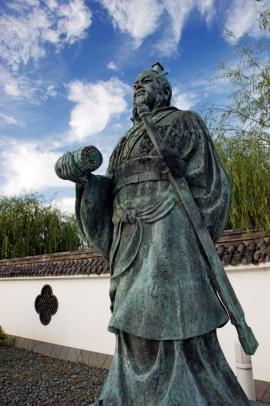 Statue of Sun Tzu in Enchoen, Yurihama, Tottori, JapanOther schools were very practical in nature. The School of the Military was concerned with military warfare and strategy. Its most famous adherent was arguably the philosopher Sun Tzu - writer of the still famous book "The Art of War".
Statue of Sun Tzu in Enchoen, Yurihama, Tottori, JapanOther schools were very practical in nature. The School of the Military was concerned with military warfare and strategy. Its most famous adherent was arguably the philosopher Sun Tzu - writer of the still famous book "The Art of War".
The School of Diplomacy emphasized political and diplomatic skills such as debating and lobbying. Whereas the agriculturalists wanted to build an egalitarian agrarian society, the Yangists believed in the positive nature of human self-interest. Two other schools that enjoyed considerable popularity at the time, but are now largely unknown, are the schools of Moism (explained in the next paragraphs) and the doctrine of Legalism (see next chapter about the Qin dynasty for an explanation of the doctrine of legalism). The Miscellaneous School tried to integrate the different teachings from all the different schools.
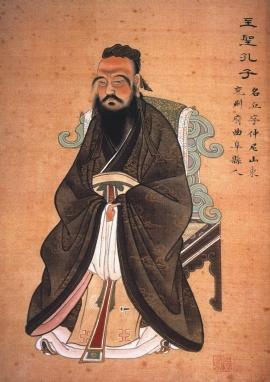 painting of ConfuciusConfucius lived between 551 and 479 BC. There are no contemporary records of him and so we have to rely on his former students (and their students in succession) who extensively wrote about their great master posthumously. Born in one of the most prosperous states, the state of Lu, he belonged to the class of the shi and he travelled extensively within the eastern part of China, offering his counsel to the rulers of many individual states. For many years, he was trying to become an influential political advisor to one of the hegemons, but was unsuccessful in this endeavour.
painting of ConfuciusConfucius lived between 551 and 479 BC. There are no contemporary records of him and so we have to rely on his former students (and their students in succession) who extensively wrote about their great master posthumously. Born in one of the most prosperous states, the state of Lu, he belonged to the class of the shi and he travelled extensively within the eastern part of China, offering his counsel to the rulers of many individual states. For many years, he was trying to become an influential political advisor to one of the hegemons, but was unsuccessful in this endeavour.
He only obtained relatively minor positions with different leaders in different states and eventually gave up his ambition of becoming a truly influential political advisor and returned to his home state of Lu. Back home, he started his 2nd career as a teacher. Most of what we know about him comes from the writings of his students (and their students in succession) about his speeches and teachings.
His core teachings are that society is a complex network of human relationships (of which the family is a microcosm) and that in order to achieve a well-ordered society we must bring order (and therefore a certain hierarchy) to human relationships. Confucius defined the five great relationships as the ones between ruler and subject, father and son, husband and wife, elder brother and younger brother, friend and friend. He saw these five great relationships as hierarchical (with one side being the leader and the other side the follower) but also reciprocal. For example, the subject had the moral obligation to obey the ruler, but only as long as the ruler was just and the wife had to obey her husband only as long as he treated her well and so on . . . .
Society was thought to function well as long as both sides fulfilled their role and duties. According to Confucius, the performance of rituals (for example children bowing in front of their parents or teachers to show their respect) was necessary to let people understand their role within the hierarchy. He spoke about "returning to the rites" and the "rectification of names" which he saw as a restoration of the proper hierarchical order that existed during the early Zhou dynasty, before local rulers began to appropriate royal titles and rituals for themselves.
He regarded the educated gentlemen of the shi class (Chinese: jun zi) as a critical element in this return to the proper order. The educated gentlemen was supposed to always follow the proper way (Chinese: dao) and therefore serve as a model citizen that other people will then try to emulate. Confucianism teaches that there is a known proper social order, that lies within the obligation of the gentlemen to be restored.
Confucius Sites in Qufu
The three Confucian sites in Qufu that are associated with Confucius who lived during the Spring and Autumn Period are the Confucius Family Mansion (Kong Fu), Confucius Temple (Kong Miao) and the Confucius Cemetery (Kong Lin). The three sites that are all centrally located in this city in the southwest of Shandong province were inscribed on the UNESCO World Heritage List in 1994.
Click here to learn more!Opening Hours
7.30am - 4.30pm
Entrance Ticket Prices
140 yuan
Through Ticket for all 3 sites (Confucius Family Mansion, Confucius Temple & Confucius Cemetery) for the same day
Confucius died in 479 BC and his philosophical work was developed further by one student of his teachings - Mencius (372 - 289 BC). Mencius especially concentrated upon the relationship between ruler and subject in his philosophical writings.
According to him, the ruler had an obligation to be a just ruler, otherwise the subject had the right to overthrow him. If the subject was successful in this endeavour, then this was a clear sign that heaven had withdrawn the mandate from this ruler (see mandate of heaven).
Mencius Sites in Zoucheng
Mencius lived in Zoucheng near Qufu during the Warring States Period. The two main sites in that small town that still remind tourists and locals of this famous Confucian philosopher, teacher and politician are the Mencius Temple and the Mencius Family Mansion. The other two visitable but lesser known sites there are the Mencius Cemetery and the Cemetery of Mencius' Mother.
Click here to learn more!Opening Hours
Temple & Mansion: 8am - 5.30pm
Entrance Ticket Prices
for the Mencius Temple & Mencius Family Mansion
March - November: 40 yuan
December - February: 30 yuan
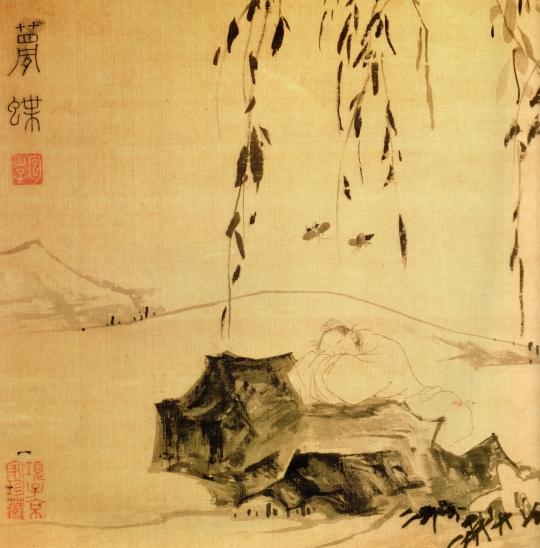 Ming dynasty painting (mid-16th century ink on silk) by Lu Chih showing Zhuangzi dreaming of a butterflyThe daoist philosophy can be traced back to the old master Laozi (who lived sometime during the 6th century BC, so at about the same time as Confucius) and his later follower Zhuangzi (who lived during the late 4th to early 3rd century BC). Where Confucianism advocates action (to restore the proper order), daoist teaching advocates inaction (Chinese: wu wei) based on uncertainty, so as not to disturb the harmony of a natural order that just "is". So in Daoism the proper way is already right there naturally and doesn't need to be "made". Daoism teaches that knowledge is always partial and that if we act upon this partial knowledge, there will be unintended consequences. Laozi's vision of a well-ordered society is an agricultural society, where all the peasant's needs are fulfilled to such an extent, that there is no need to endeavour outside their home village (and therefore outside the proper order).
Ming dynasty painting (mid-16th century ink on silk) by Lu Chih showing Zhuangzi dreaming of a butterflyThe daoist philosophy can be traced back to the old master Laozi (who lived sometime during the 6th century BC, so at about the same time as Confucius) and his later follower Zhuangzi (who lived during the late 4th to early 3rd century BC). Where Confucianism advocates action (to restore the proper order), daoist teaching advocates inaction (Chinese: wu wei) based on uncertainty, so as not to disturb the harmony of a natural order that just "is". So in Daoism the proper way is already right there naturally and doesn't need to be "made". Daoism teaches that knowledge is always partial and that if we act upon this partial knowledge, there will be unintended consequences. Laozi's vision of a well-ordered society is an agricultural society, where all the peasant's needs are fulfilled to such an extent, that there is no need to endeavour outside their home village (and therefore outside the proper order).
The philosopher Mozi (who lived during the late 5th to early 4th century BC) advocated the practice of universal love which according to this school of thought meant to treat everyone equally and fairly and not just the immediate family members. The Moists argued that it was precisely the emphasis on one's immediate family (as propagated by Confucianism) that created the turmoil and conflict in China when many individual states (each led by a ruling family) went to war against each other.
Interestingly, the Moists were not only concerned with their philosophical teachings but also pursued an active plan of action. They taught themselves to become experts in defensive warfare and offered their services to the rulers of smaller states. Their hope was to stop the continuing warfare in China by building up the individual state's and/or city's defences to such a degree, that military warfare would cease to be an effective way to pursue one's own interests and that therefore the ruling families would have to rely on other means (such as diplomacy) to achieve their objectives. For some states this strategy proved to be effective.
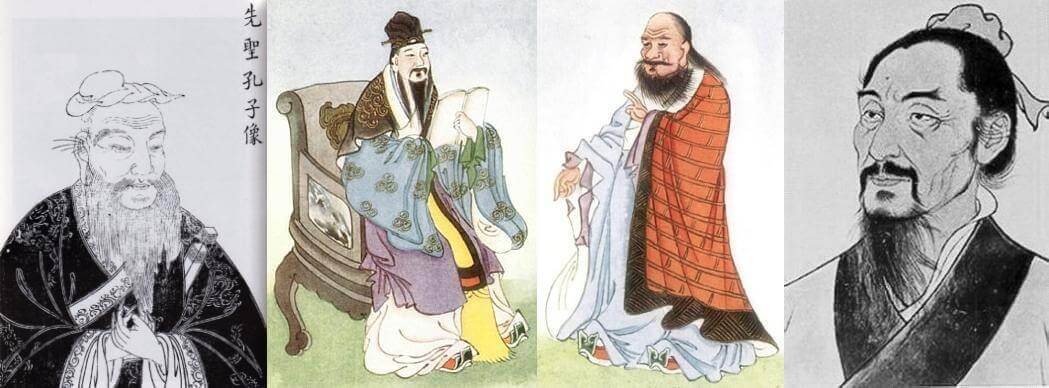 Left: Confucius as scholar Middle Left: the Confucian philosopher Mencius Middle Right: Portrait of Laozi Right: drawing of the Chinese political philosopher and religious reformer Mozi
Left: Confucius as scholar Middle Left: the Confucian philosopher Mencius Middle Right: Portrait of Laozi Right: drawing of the Chinese political philosopher and religious reformer Mozi
The Warring States Period (476 - 221 BC)
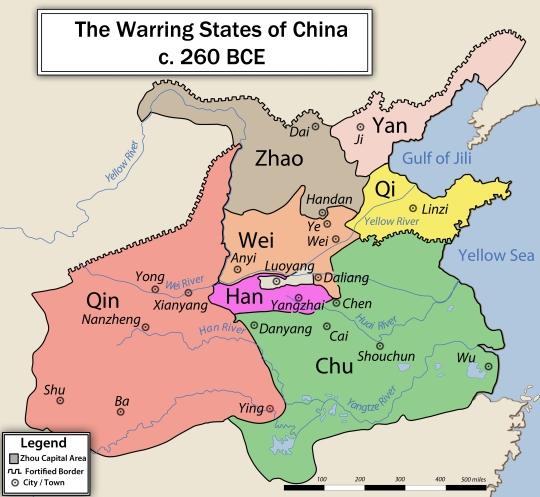 Warring States Period Map 260 BCThe Spring and Autumn Period had a clear starting point, when the Zhou abandoned their capital in 771 BC and moved eastward. However, there is no clear starting point for the Warring States Period. The date 476 BC chosen here is based on Sima Qian's Records of the Grand Historian. The Warring States Period got its name from the Record of the Warring States.
Warring States Period Map 260 BCThe Spring and Autumn Period had a clear starting point, when the Zhou abandoned their capital in 771 BC and moved eastward. However, there is no clear starting point for the Warring States Period. The date 476 BC chosen here is based on Sima Qian's Records of the Grand Historian. The Warring States Period got its name from the Record of the Warring States.
Whereas the number of states increased during the Spring and Autumn Period, it began to decrease during the Warring States Period with stronger states invading and assimilating weaker states. The area that is now China became less and less fragmented again. By the 3rd century BC, there were only 7 larger states (Qin, Han, Wei, Zhao, Qi, Chu, Yan) and a couple of smaller states left.
Of these 7 larger states, the state of Qin was the most successful in its military campaigns. It was the Qin, who brought the Eastern Zhou dynasty (a minor state during the Spring and Autumn Period as well as the Warring States Period) to an end in 256 BC, when they invaded the Eastern Zhou capital and killed their last king.
Under successive rulers, the Qin state's military strength grew substantially, which led to a rapid expansion of its territory in northwest China. Eventually, a new powerful Qin king would succeed in unifying China.
Chinese History Digest's summary of China's history continues with the story of the short-lived Qin dynasty in the next section.
